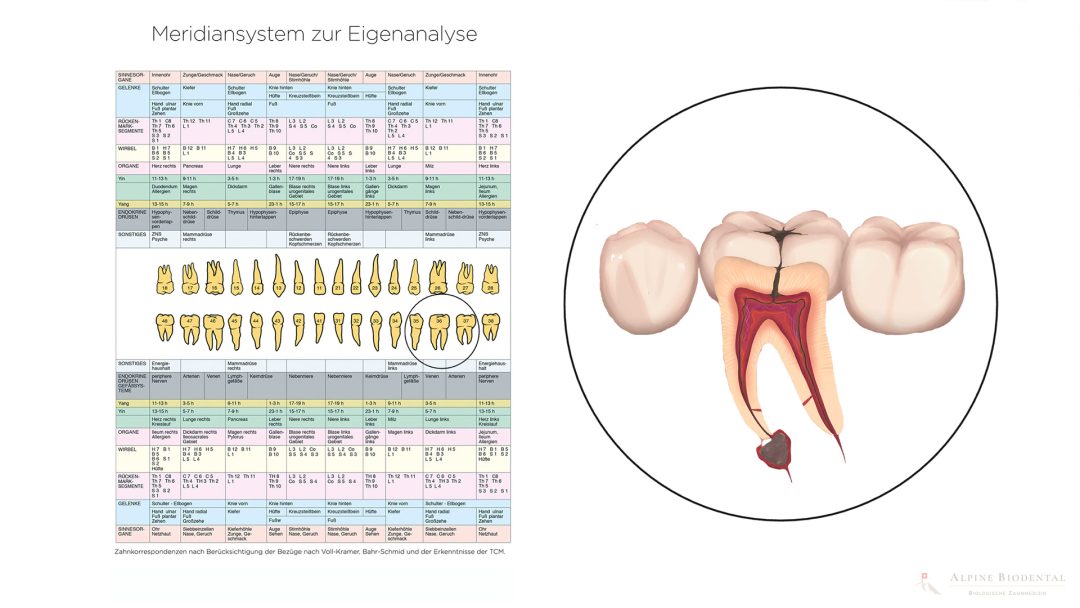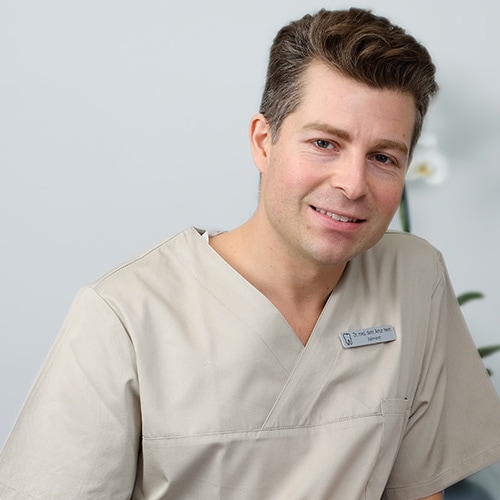Holistic Dentistry

Holistic dentistry is a dental field that considers issues in the oral cavity from the perspective of their root causes, recognizing the constant interaction between the mouth and the entire body.
Holistic dentistry is closely linked to Biological Dentistry at its core. Both disciplines are centered around diagnosing and treating the root causes of diseases, with symptomatic therapy taking a secondary role.
Dental disturbances often extend beyond the oral cavity and can holistically impact the health of various organs.
This article explores the interplay between teeth and organs, highlighting the bidirectional influence that can occur.
In our practice, holistic dentists work towards the goal of restoring patients to health and permanently enhancing their quality of life. Each dentist possesses their own core competencies, ensuring that all aspects are comprehensively addressed to provide the patient with the best possible outcome.
Tooth-Organ Relationship – The Meridian System
Meridians play a crucial role in holistic dentistry.
Teeth and organs are interconnected through the meridian system. Acupuncture points, small nodes that can be stimulated by needles, targeted pressure, or heat, are located on these energetic pathways.
If there is an issue on a meridian, all organs located on that meridian can be negatively affected and may also become ill. For example, a diseased upper molar can influence the thyroid. Conversely, an issue with the thyroid can impact the upper back tooth.
Overall, the burden on organs from teeth is greater and more frequent. Teeth are vulnerable due to the consumption of sugar and poor oral flora. Conditions such as cavities, periodontitis, old fillings, and jaw inflammation can damage the tooth, affecting the corresponding meridian.
Periodontitis
Periodontitis is the inflammation of the supporting structures of the tooth (periodontium), the structures that anchor the tooth firmly in the jawbone. Commonly referred to as periodontal disease, if the inflammation is limited to the gums, it is called gingivitis.
The main cause of periodontitis is bacterial destruction of the tooth-supporting structures. Tissue reacts to the invasion of harmful bacteria with signs of inflammation (e.g., bleeding, pain, warmth). These harmful bacteria are also known as periodontal pathogens.
Such inflammation in the tooth-supporting structures leads to the gradual loosening of teeth and eventual tooth loss in the oral cavity. Bad breath or halitosis is also noticeable.
Moreover, the body experiences health challenges. Harmful periodontal pathogens pass through the open, inflamed tooth-supporting structures into the bone and consequently into the interior of the body. From there, they spread throughout the entire organism via the bloodstream.
Studies have conclusively demonstrated the following associations:
- Atherosclerosis (calcification) of the coronary arteries, with heart attack as a late consequence
- Atherosclerosis of blood vessels in the brain, with stroke as a late consequence
- Diabetes
- Inflammatory joint diseases such as arthritis and rheumatism
Persistent, chronic periodontitis leads to tissue acidification. The body must counteract and mobilize substances to buffer the acids, drawing on its most significant mineral reservoir – the bones. The result is osteoporosis.
When adding up the surface area of inflammation in severe periodontitis, it equals the palm of an adult. This extensive inflammatory burden, combined with bacteria entering the interior of the body, is the reason for the severe health consequences.

From a holistic perspective, it is of great importance that the inflammation of the tooth-supporting structures is completely treated. Following this initial therapy, maintaining an inflammation-free condition permanently is crucial.
In our practice, we have a specialized prophylaxis concept that effectively builds up oral flora. This lays the foundation for lasting dental health.
Dr. Artur Hein
Integrative dentistry is a complex and extensive field of dentistry. Our experienced specialists are here to assist you personally.

Misalignment of the Temporomandibular Joints
The temporomandibular joints (TMJ) are the most complex joints in the human body. Connected by the lower jaw, they are also subjected to the significant forces exerted by the chewing muscles.
The position of the temporomandibular joints is primarily determined by tooth contacts.
When the teeth are in the correct position relative to each other, and the contacts between upper and lower teeth are physiological, the temporomandibular joints are usually in a healthy and balanced position.
However, if the teeth exhibit contacts at incorrect positions that disrupt the bite, the temporomandibular joints are forced into misalignment. As long as such a malocclusion or forced bite persists, the temporomandibular joints remain trapped in this pathological position. Over time, various temporomandibular joint disorder (TMJ) symptoms may develop, causing a significant disruption to the entire body.
The improper position of the temporomandibular joints can unfavorably affect body posture, leading to descending issues. Changes in body posture, misalignment of joints, and opposing muscle groups working against each other may occur.
Consequently, conditions such as osteoarthritis, painful muscle tension, or herniated discs can develop.
Due to the proximity of the temporomandibular joints to the ears and eyes, tinnitus, dizziness, and vision problems are common manifestations of TMJ.
The temporomandibular joints hold a central, holistic significance and must not be neglected from a dental perspective. As long as the patient’s incorrect bite persists, the described problems remain. Only the decoupling of the temporomandibular joints from the pathological tooth position with a TMJ splint and a redesign of the bite situation can bring about health improvement. This should be considered in every treatment involving dental prosthetics. Also, read about TMJ splints.
Bite Height and the Brain
Another crucial aspect in considering bite height and temporomandibular joints is the blood supply to the brain.
Throughout life, especially due to teeth grinding, the teeth continuously wear down. This leads to a loss of bite height, where, upon biting, the upper and lower jaws progressively approach each other. As a consequence, the temporomandibular joint is compressed upward and pushed backward towards the ear.
This compression in the temporomandibular joint results in muscle tension in the head region, causing the various skull bones to lose their free movement. These physiological, subtle movements of the skull bones are detectable with every motion and even with each pulse beat.
Due to the muscle tension caused by compression in the temporomandibular joint, there is a blockade of these bone movements. As a result, the blood vessels in the head can expand and contract less effectively.
As a consequence, less oxygen-rich blood reaches the brain, and simultaneously, the removal of oxygen-poor, “used” blood is reduced.
This correlation leads patients to experience symptoms such as difficulties in concentration, impaired cognitive function, and mental fatigue.
Since the removal of breakdown products and accumulated toxins is also less effective, the brain’s detoxification capacity is compromised. This can strongly favor degenerative brain diseases, such as Alzheimer’s and dementia.
In this aspect as well, the temporomandibular joints play a central role and should not be neglected by a holistic dentist.
Impact of Dental Materials
In dentistry, a myriad of materials is used, surpassing any other medical field. Most of these materials have chemical compositions that can have adverse health effects on the body.
The biological effects of dental materials can be both toxicological and allergological. In other words, these materials can be toxic and lead to various types of allergies.
Poisoning that can occur in dental practices is typically chronic (long-term) and rarely acute.
Allergic reactions are generally chronic, nonspecific, affecting the entire body, and are less likely to manifest as an immediate local response.
Some holistic burdensome materials in dental practices include:
- Amalgam and other metals
- Materials used in root canal treatments
- Plastics in fillings
- Plastics in dentures
- Impression materials
- Cements for cementing dental prosthetics
Dentistry encompasses a wide range of materials. To minimize the impact on patients’ health, dentists should use materials that, from a biological perspective, pose the least burden. Characteristics such as durability, precision, and stability should not be overlooked.
Holistic and biological dentistry adheres to the principle of minimizing the burden. In every treatment, materials are chosen that interfere as little as possible with the patient’s health.
Jaw Infections
Jaw infections are often not painful and manifest as a gradual process. Typically, the adjacent jawbone is also affected.
Jaw infections originating from a tooth are referred to as granulomas, cysts, or abscesses (acute), usually located at the root tip. The cause of these dentogenic jaw infections is pathogenic bacteria that penetrate the jawbone through cavities or periodontitis, leading to inflammatory bone degradation. The affected tooth usually dies and remains as dead tissue in the body.
Other chronic infections can persist in the jawbone after tooth extraction. Such fatty degenerative bone inflammation is also known as FDOJ/NICO (Fatty Degenerative Osteonecrosis of the Jawbone / Neuralgia-Inducing Cavitational Osteonecrosis). Common locations for these types of inflammations include areas around the former wisdom teeth. Therefore, various factors should be considered when removing wisdom teeth or teeth in general.
As bone inflammations have a holistic impact, significantly weakening and affecting the body, they should be completely eliminated. Additionally, the cause should be identified and corrected to prevent future inflammations in the jawbone.
Frequently asked Questions on Holistic Dentistry
Holistic dentistry is a broad and complex field. We are more than happy to assist you with any questions you may have.
In traditional folk medicine, the upper canine tooth is often referred to as the “tooth of the eye,” and the lower wisdom tooth as the “tooth of the ear.” However, each tooth is connected to various organs, and most organs are influenced by several teeth. The specific correlation between teeth and organs can be found in the following section.
- Upper Incisors (Teeth 12, 11, 21, 22): Kidneys, Bladder, Reproductive Organs, Pineal Gland (important for sleep-wake cycle), Smell
- Upper Canines (Teeth 13, 23): Liver, Gallbladder, Eyes
- Upper Premolars (Small Molars, 15, 14, 24, 25): Lungs, Stomach, Smell
- Upper Molars (Large Molars, 17, 16, 26, 27): Pancreas, Colon, Thyroid, Taste
- Upper Wisdom Teeth (Teeth 18, 28): Small Intestine (often related to allergies), Heart, Hearing
- Lower Incisors (Teeth 32, 31, 41, 42): Kidneys, Bladder, Reproductive Organs, Smell
- Lower Canines (Teeth 33, 43): Liver, Gallbladder, Eyes
- Lower Premolars (Small Molars, 35, 34, 44, 45): Pancreas, Stomach, Taste
- Lower Molars (Large Molars, 37, 36, 46, 47): Lungs, Colon, Smell
- Lower Wisdom Teeth (Teeth 38, 48): Small Intestine (often related to allergies), Heart, Hearing
Gum recession is influenced by various factors, including:
- Poor bacteria balance in the oral cavity
- Incorrect brushing technique with overly hard toothbrushes
- Chronic trauma and displacement of the gums due to interdental brushes and dental floss
Gum pockets are primarily caused by pathological periodontal bacteria and are a symptom of gum inflammation and periodontitis.
The primary cause of gum bleeding is the colonization of the oral flora by pathogenic, disease-causing bacteria.
Jaw clicking always involves increased friction and compression of anatomical structures in the temporomandibular joint. This can persist for a long time, or even throughout one’s life, without any symptoms. However, this continuous strain can also become noticeable and lead to symptoms such as temporomandibular joint pain.
Inflammation in the mouth can cause unpleasant pain. Baking soda is a household remedy that can help reduce pain and swelling. You can dissolve a teaspoon of baking soda in a glass of warm water and use it as a mouthwash. However, its effect is only symptomatic relief, and long-term resolution may still be necessary.
Further Information
The additional information is intended to provide you with a better overview of the topic.